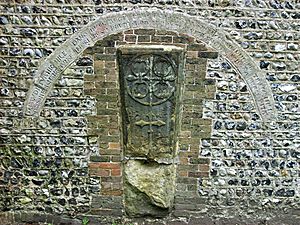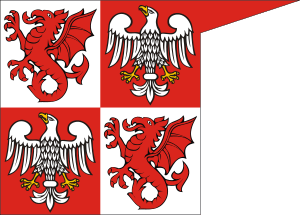Magnus, son of Harold Godwinson facts for kids
Magnus (who lived around 1068) was a son of Harold Godwinson, who was King of England. After the Norman conquest of England, he was likely forced to leave England and go to Dublin. He went with two of his brothers. From Dublin, he took part in one or maybe two attacks on south-western England. These attacks were not very successful in terms of winning battles. They might have even cost him his life.
Contents
Magnus's Family and Early Life
We don't know exactly when Magnus was born. However, we think his older brother was born in the mid-1040s. This helps us guess Magnus's age. His family, the House of Godwin, was one of the most powerful families in England before the Normans arrived. His grandfather was Godwin, Earl of Wessex. His father, Harold Godwinson, later became Earl of Wessex too.
Magnus's mother was Edith Swan-neck. She and Harold were married "in the Danish way." This type of marriage was not recognized by the Church. However, many people at the time thought it was a proper marriage. For example, Harold Harefoot became king even though his parents had this kind of marriage.
Harold Godwinson had five sons. Magnus was probably the second or third of these sons. He was likely named after Magnus the Good, a king of Norway. Magnus Haroldson probably received a good education, as was normal for the son of a powerful nobleman. This education focused on military skills and how to deal with other important people. He was too young to fight for his father at the famous Battle of Hastings. However, he had chances to use his skills in the years that followed.
Fighting Back in South-West England
Harold Godwinson's defeat and death at the Battle of Hastings was a terrible event for his family. After Harold died, important English leaders in London chose Edgar Ætheling as king. Edgar was a great-nephew of Edward the Confessor. Edgar's short "reign" ended when William the Conqueror reached London in December 1066. Edgar was never actually crowned king.
Magnus's grandmother, Gytha, was the widow of Earl Godwin. She went to south-west England to try and keep her power there. This part of the country had not yet been conquered by William. But in early 1068, William led his army against her. He surrounded her in the city of Exeter.
The old records don't specifically say Magnus was part of this fight. However, it is very likely that he and his brothers, Godwin and Edmund, were there. They would have been trying to lead the English people against William. After eighteen days, Exeter surrendered to William. But by then, Gytha and perhaps her grandchildren had escaped. They found safety on an island in the Bristol Channel, probably Steep Holm.
Attacks from Ireland
That summer, Magnus's brother Godwin was in Dublin, Ireland. He was protected by King Diarmait of Leinster. Years before, Diarmait had also given safety to their father, Harold.
Some historians believe Magnus was with Godwin and Edmund. Others think it was Edmund and their cousin Tostig. They seemed to have some of Harold Godwinson's remaining housecarls (loyal soldiers) with them. They also had enough money to give gifts to King Diarmait. One gift was a "battle standard of the king of the Saxons." They also hired a group of soldiers called mercenaries.
With a fleet of 52 ships, they sailed to the Bristol Channel. First, they attacked the area near the mouth of the River Avon. Then they attacked Bristol. The people of Bristol fought them off. So, they sailed back to the Somerset coast and landed again. They might have hoped to find a friendly welcome there and gather more men. However, they were disappointed.
They met a local army led by Eadnoth the Staller. A bloody battle took place at Bleadon. Eadnoth was killed in this battle. It's possible Magnus also died there. After attacking Devon and Cornwall, the surviving brothers went back to Dublin. They were richer, but they hadn't won any big military victories. So, we are not sure if Magnus was part of this raid, or if he survived it if he was.
There are no more clear mentions of Magnus in old writings. However, it is recorded that two of Harold's unnamed sons made a second attack on south-west England in the summer of 1069. This attack ended badly at the Battle of Northam in Devon. Many of the brothers' best men were killed in this battle.
Stories of His Survival
One interesting clue suggests Magnus might have survived these events. He might have retired to a religious life in Sussex. This area was the original home of his family, the House of Godwin. There is an old stone monument built into a wall of the Church of St John sub Castro, Lewes. It has a Latin message that has been translated:
"A warrior of Denmark's royal family enters this cell; Magnus is his name, a sign of his great family. Giving up his power, he becomes gentle like a lamb, and to gain eternal life, he becomes a humble anchorite (a person who lives alone for religious reasons)."
A story from the early 1800s says this was Magnus Haroldson. He was indeed related to the Danish royal family through his great-uncle Ulf the Earl. This connection made him a relative of King Sweyn II. The famous historian Frank Barlow took this idea seriously. However, the style of the letters on the stone might be from a later time, perhaps around 1200.
Some historians have also suggested another idea. A historian named Tomasz Jurek believes that a man called Magnus, Count of Wrocław, was actually Magnus Haroldson. This Magnus, Count of Wrocław, was a royal who arrived in the 1070s from a land that had just been taken over by foreign rule. This fits with Magnus Haroldson's situation after the Normans conquered England.
After Harold's defeat by William the Conqueror, Magnus's sister Gytha of Wessex and at least two of her brothers (thought to be Godwin and Edmund) went to the court of their cousin, King Sweyn II of Denmark. Gytha later married Vladimir II Monomakh, who became a powerful ruler in Kievan Rus.
A Polish historian, Marek Skarbek-Kozietulski, built on Jurek's idea. He thought that Magnus Haroldson, after staying in Denmark, traveled to Poland. He believed Magnus made an important marriage to a woman who might have been an unrecorded sister of King Bolesław II the Generous. Skarbek-Kozietulski also discussed an idea that Bolesław II's wife was an illegitimate daughter of Sweyn II of Denmark. If so, it might have been arranged for Haroldson to marry one of her sisters. This would make him Bolesław's brother-in-law and explain Magnus's new title and status.
Regardless of whom Magnus married, Skarbek-Kozietulski believed these ideas, along with other clues, support the theory. One clue is the sudden appearance of the Anglo-Saxon wyvern (a type of dragon) in the flag and coat of arms of the later Duchy of Masovia. This symbol was not known in Polish heraldry before. Another clue is the presence of certain Y-DNA types (I1-ASP and I1-T2) in various Polish noble families. These DNA types are originally found in England and Denmark.
A town near the castle of Czersk, where Magnus's supposed remains were found in 1966, is called Magnuszew. Historians from the 1900s also thought that Magnus, Count of Wrocław, was the grandfather of Piotr Włostowic. Piotr Włostowic was an important leader for Duke Bolesław III Wrymouth and the founder of the Duninowie clan.
Images for kids





